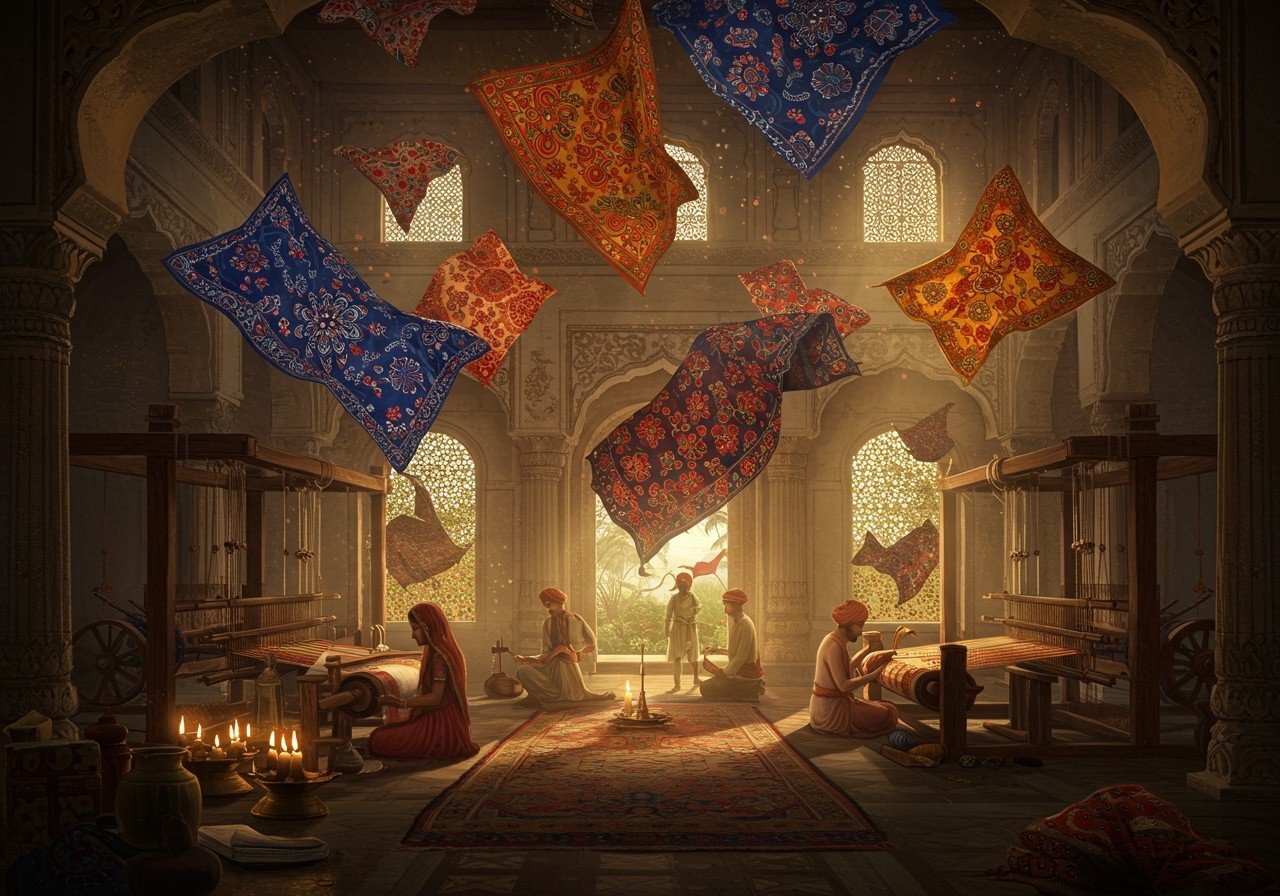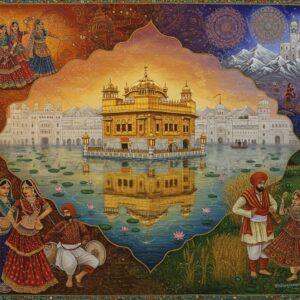
Indian textiles boast a rich history, reflecting India’s artistic brilliance and cultural heritage. From ancient times to the British colonial era, Indian textiles have undergone a remarkable evolution, playing a significant role in society and global trade. Each region of India has nurtured its own unique textile traditions and techniques.
Textile Industry in Ancient India (3rd Century BC)
The roots of textile production in India trace back to the Indus Valley Civilization (around 3rd century BC). Early Indians skillfully utilized natural fibers like cotton and silk, developing sophisticated weaving techniques. Textiles held a crucial role in the economy, even serving as currency and symbols of status. Indian textiles were pivotal in ancient trade routes like the Silk Road, connecting India with Europe and Asia. Religious and cultural practices deeply influenced textile designs, with natural dyes and intricate patterns being prominent features. You can explore similar traditional threads at poojn.in.
Indian Textiles in the Medieval Period (12th-15th Century)
The medieval period witnessed a significant transformation in Indian textiles. Regional centers thrived, each showcasing its distinctive style and techniques. Islamic influences brought new patterns and methods, blending Persian and Indian artistry to create exquisite fabrics admired worldwide. The textile trade expanded remarkably, with Indian muslins gaining immense popularity in Europe and the Middle East for their lightness and softness. Vibrant chintz prints and richly textured brocades also found eager buyers across continents. Indian textiles became synonymous with luxury in the global market. Artisan communities played a vital role, preserving traditional skills through guilds, ensuring knowledge transfer across generations. Cultural exchanges further enriched textile designs, as techniques and motifs were shared between neighboring regions, establishing India as a hub of textile expertise. For modern rituals and ceremonies, explore high-quality cotton threads at poojn.in.
Impact of Colonialism on Indian Textiles
The British colonial period drastically altered the Indian textile landscape. British policies favored imports from England, severely impacting local production. Traditional textile centers declined, affecting artisans and weavers. Mechanized mills shifted the focus from hand-woven fabrics to machine-made textiles, altering production methods and impacting artisan communities. Despite these hardships, Indian textiles became a symbol of resistance during the Swadeshi Movement, promoting locally made goods. Indian weavers and artisans displayed remarkable resilience, upholding their craft in the face of adversity.
Cotton Textile Industry Under British Rule
The cotton textile industry underwent a major transformation under British rule. Mechanized spinning and weaving revolutionized cotton production. Textile mills emerged in major cities, contributing to urbanization and industrial growth. British tariffs hampered India’s cotton exports, creating challenges for local markets. However, Indian entrepreneurs strived to reclaim the industry, promoting indigenous textile production and revitalizing traditional crafts. The perseverance of cotton farmers and weavers highlighted their determination to preserve their heritage, adapting and innovating to ensure the industry’s survival. Poojn.in offers a variety of cotton threads perfect for maintaining these traditions. Find the perfect thread for your needs at poojn.in.
Cultural Significance and Legacy
Indian textiles continue to hold profound cultural significance, representing identity and heritage. They are deeply ingrained in everyday life, with traditional techniques experiencing a revival as appreciation for handmade products grows. Indian textiles influence global fashion trends and design collaborations, with designers incorporating traditional crafts into modern designs. Government and non-profit organizations support sustainable practices within the industry. Textiles remain essential to Indian rituals and festivals, embodying cultural continuity and diversity. Indian textiles are more than just fabrics; they are narratives woven with threads of history and tradition, captivating hearts worldwide and preserving a proud legacy.
How Poojn.in Supports India’s Textile Heritage
Poojn.in offers authentic cotton threads (सूती धागा) connecting you to India’s rich textile traditions. These threads are ideal for traditional rituals and crafts, maintaining the quality standards that have been integral to Indian culture for generations. Our collection includes pure cotton threads for religious ceremonies, multi-colored threads for ritual purposes, sacred threads (janeu/yagnopavit), Kalava (sacred red thread), and bulk packs for temples and institutions. We provide nationwide delivery with secure packaging to ensure purity, sourcing our threads from trusted manufacturers who uphold traditional production methods while meeting modern quality standards. Visit poojn.in to explore our complete range of cotton threads and other textile-based puja items. Our customer service team is available to assist you in selecting the perfect threads for your specific ritual needs.
Conclusion: Weaving a Legacy
Indian textiles embody the nation’s rich history and cultural diversity. From ancient times to the British Raj, these fabrics have woven tales of innovation, resilience, and artistry. Despite the challenges faced during colonial times, the spirit of Indian weavers and artisans persevered. They preserved their traditions and adapted to changing circumstances, ensuring their craft’s survival. Today, Indian textiles are globally acclaimed for their beauty and craftsmanship, inspiring designers and captivating audiences. As appreciation for sustainable and handmade products grows, traditional techniques find new life in contemporary markets. These textiles are a living heritage, representing Indian identity and culture, vital in rituals, festivals, and daily life. With every thread, Indian textiles weave a tapestry of stories, honoring the past while embracing the future.
FAQs on Indian Textiles
What is the history of the textile industry in India? The Indian textile industry boasts a rich history, dating back to ancient civilizations (around 3rd century BC) with hand-spun and hand-woven fabrics like cotton and silk. India was renowned for its diverse textile traditions long before British colonization.
How did the textile industry evolve in ancient India? Ancient India witnessed the evolution of textile production through innovations in weaving techniques and dyeing methods. Fabrics like muslin and silk gained prominence, traded across vast distances via established routes, spreading Indian textiles worldwide.
What was the role of textiles in ancient trade? Textiles played a pivotal role in ancient trade. Indian fabrics were highly valued commodities, traded across Asia, Europe, and Africa. Considered luxury items, they were exchanged for gold, spices, and other goods.
How did British rule affect the textile industry in India? British rule imposed significant challenges on the Indian textile industry. Policies favored British textiles, with heavy taxes on Indian products and cheap imports leading to a decline in India’s traditional textile sector.
What changes did the cotton textile industry experience during British rule? The introduction of mechanized mills marked a significant change in the cotton textile industry under British rule. However, British control over these mills impacted local artisans and reduced the demand for hand-woven cotton fabrics.
Why were Indian textiles so popular in ancient times? Indian textiles earned their popularity through their exceptional quality, vibrant colors, and intricate designs. Techniques like block printing and tie-dyeing created unique patterns highly sought after globally.
How did traditional weaving techniques survive British rule? Traditional weaving techniques endured British rule due to the dedication of artisans and the support of local communities. Small-scale production continued, preserving ancient practices and cultural heritage.


